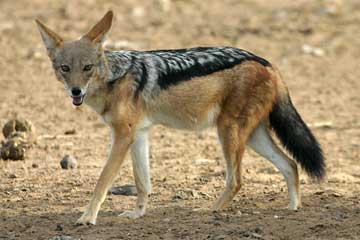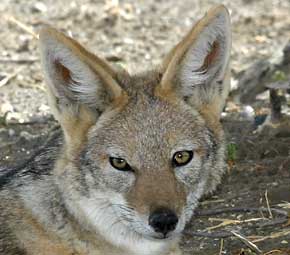Contact Details: Scotch Macaskill, Dirt Road Traders, Currys Post Road, Howick, KwaZulu-Natal, South Africa. Tel: +27 (0)82 578 2329. Privacy: Your privacy is guaranteed. See our Privacy Policy for more. This site accepts advertising and other forms of compensation - see Disclosure and Advertising for details. Site updated: 2022. Copyright © 2002 - 2022 Scotch Macaskill

| ||||||||||
|
||||||||||
|
See also info about: |
Black-backed Jackal Information
Black-backed jackals are members of the Canidae family and as such are true dogs. Other jackals of the Canidae family are the less-common side-striped jackal (Canis adustus), and the golden or common jackal (Canis aureus) found mainly in North Africa. The information here applies to the black-backed jackal as it is common in Southern and East Africa and is the jackal most likely to be spotted by those on safari. Appearance:
The face, flanks and legs are reddish-brown, while the throat, chest and underparts come in varying shades of white. The upright, pointed ears are reddish on the outside with white hair lining the inside. The long tail is black and bushy. For us humans, who relate so well to domesticated dogs, the black-backed jackal is an attractive-looking animal. However, the pointy nose might not appeal to everyone, suggesting the "slyness" and cunning of a fox. What do you think? Feel free to add your comments in the box below. Behavior:
Jackal pairs form a monogamous bond for life, with both the male and female marking and defending territories. They generally only leave their territories in search of water, or to feed on larger carcasses when there is diminished hostility from other jackals. Once the food is finished, individuals and pairs return to their territories. When the jackal is resting in the heat of the day, it will usually be found dozing under a shady bush, although it may also lie in a burrow dug by other species. Reproduction:
Male partners actively take part in parenting by bringing food to the mother when she's confined to her "den". They are often assisted in this by prior offspring who have delayed their departure into the big wide world for a season or two. Diet:
In farming areas, black-backed jackals have a reputation for preying on livestock, particularly the young of sheep and goats. This makes them the target of farmers, but they are difficult to control because they quickly learn how to avoid traps and poisoned bait. However, studies in South Africa have shown that the jackal's reputation is not deserved as the chief culprits in killing of livestock are in fact domestic dogs. Also, instead of resorting to traps and poison, farmers in Namibia and South Africa are turning to other methods of protecting their animals, including the use of Anatolian sheperd dogs. Sounds:
To find out about the main differences between side-striped and black-backed jackals, see our blog post, Side-Striped Jackal at Dusk, and for additional information about jackals, see our gallery of Jackal Pictures. Return to Wildlife Info . |
|||||||||
|
|
||||||||||

 Black-backed jackal with pointy face and big ears
Black-backed jackal with pointy face and big ears
